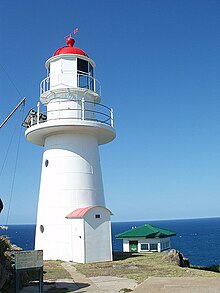Double Island Point Light

Double Island Point Light, 2006
|
|
|
Queensland
|
|
| Location |
Double Island Point Queensland Australia |
|---|---|
| Coordinates | 25°55′54.3″S 153°11′26.4″E / 25.931750°S 153.190667°ECoordinates: 25°55′54.3″S 153°11′26.4″E / 25.931750°S 153.190667°E |
| Year first constructed | 1884 |
| Construction | timber frame clad with galvanized iron |
| Tower shape | conical frustum tower with double gallery and lantern |
| Markings / pattern | white tower and lantern, red lantern dome |
| Height | 39 feet (12 m) |
| Focal height | 315 feet (96 m) |
| Current lens | VRB-25 |
| Light source | solar power |
| Intensity | 48,430 cd |
| Range | 17 nautical miles (31 km; 20 mi) |
| Characteristic | Fl W 7.5s. |
| Admiralty number | K2912 |
| NGA number | 111-5660 |
| ARLHS number | AUS-065 |
| Managing agent | Australian Maritime Safety Authority |
Double Island Point Light is an active lighthouse located at the summit of Double Island Point, a coastal headland within the Cooloola section of the Great Sandy National Park. It is located at the southern end of Wide Bay, 70 kilometres (43 mi) north of Noosa Heads, Queensland, Australia.
Though the location was indicated for a lighthouse in 1864, it was only constructed in 1884, by W. P. Clark, who constructed other Queensland lighthouses. Upgrades to the kerosene fueled light and the lens occurred in 1923 and 1925. A major reconstruction occurred in 1933 when the light was converted to 110 V electricity, significantly increasing its luminosity, and new cottages replaced the originals. In 1980 the light was converted to 240 V and finally, solar conversion took place in 1991. Double Island Point Light became automatic the following year.
The lighthouse is typical for Queensland, made of timber frame clad with galvanized iron plates, painted white with a red dome. It is surmounted by an original Chance Brothers lantern with a modern VRB-25 self-contained rotating beacon mounted inside. It is surrounded by several auxiliary structures. The two lighthouse keepers' cottages, hardwood framed and sheeted with asbestos cement, are at a lower level, with a few other buildings. The site is positioned in the Great Sandy National Park, but there is no public access to the lighthouse.
The colony of Queensland was formed in 1859. In 1862, the Queensland government appointed the first Portmaster, Commander George Poynter Heath. However, it was only in 1864 that two committees were appointed to deal with the issue of coastal lighthouses. One of the locations indicated by these committees as a possible suitable site was Double Island Point. However, it was to take almost two decades until the Queensland Government took action upon this recommendation.
In 1881 or 1882 Heath made a report to the Parliament stating the need for the lighthouse. In 1883 he made a visit to the island and realised that the original planned location, halfway up the point, would result in a light that would not be visible to the north. He advised that the lighthouse will be constructed at the summit of the point, with a 3rd Order light, a more powerful light than originally planned, and advise which was accepted. Plans were made by the Queensland Colonial Architect's Office, and at the end of June 1883 tenders were called, for the construction of the lighthouse and lighthouse keeper cottages, for both Double Island Point Light and c. The contract for both lightstations, for the cost of £6900, was awarded to W. P. Clark, who already constructed Queensland's first lighthouse since Queensland's formation, Bustard Head Light (in 1868), and who was also awarded the contract for Low Isles Light in 1877 and for Cape Cleveland Light and Dent Island Light in 1878.
...
Wikipedia

